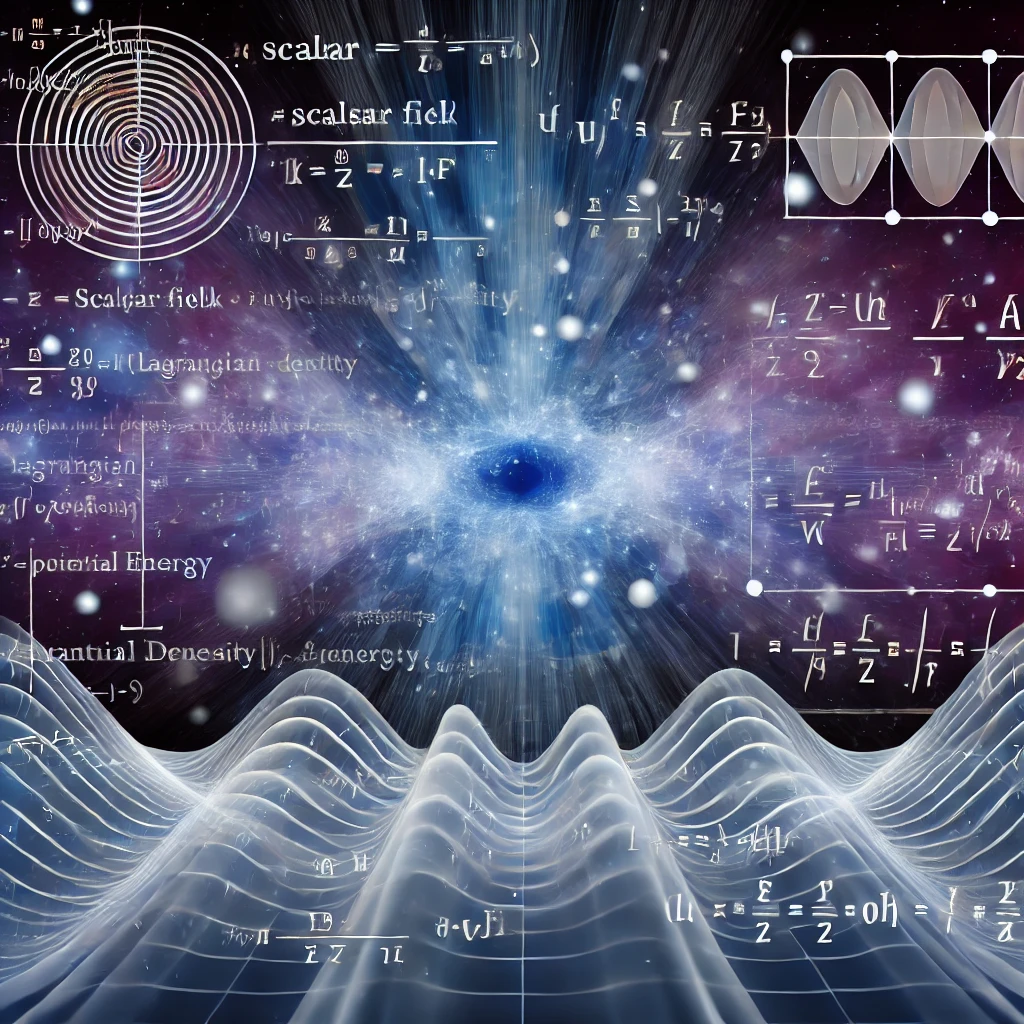
The Vibrational Field Dynamics (VFD) framework relies heavily on established concepts in theoretical physics, including elements from quantum field theory, general relativity, and cosmology. It utilizes familiar mathematical structures such as Lagrangian densities, spontaneous symmetry breaking mechanisms, quantization procedures, and coupling to gravity. However, the novelty of VFD is not in inventing entirely new formulas but in how it combines existing tools to propose a unified, holistic theory of fundamental interactions.
How VFD Differs from Standard Physics
The Universal Scalar Field (ϕ):
While scalar fields like the Higgs field are common in physics, VFD posits a single scalar field (ϕ) that underlies all forces and particles. This conceptual shift means that instead of different fields being responsible for different forces, all forces arise from different vibrational states of this one field.
The field ϕ permeates the entire universe and provides the foundational medium for everything in nature, unifying disparate interactions under a single theoretical entity.
Unification of Fundamental Forces:
VFD offers a unification of gravity, electromagnetism, and nuclear forces by interpreting them as various manifestations of the scalar field ϕ. Traditional physics treats these forces as distinct, but VFD suggests that these distinctions are emergent phenomena based on how the scalar field vibrates and interacts.
Although methods such as coupling the field ϕ to the metric tensor (to describe gravity) are standard, VFD uniquely uses this coupling to explain how quantum mechanics and gravity might coexist harmoniously.
Dark Matter and Dark Energy Explained via Negative Energy Densities:
In VFD, dark matter and dark energy are interpreted as arising from regions of negative energy density within the scalar field ϕ. Traditional physics introduces separate entities (e.g., weakly interacting massive particles, or WIMPs, for dark matter), whereas VFD suggests that the apparent effects of dark matter and dark energy are natural consequences of how ϕ behaves across spacetime.
This perspective leverages existing mathematical tools but presents a novel interpretation, potentially eliminating the need for exotic particles or fields to explain these mysterious components of the universe.
Explaining Key Formulas in VFD
Here, we break down some of the key mathematical formulations in VFD for those with a basic understanding of mathematics.
Lagrangian Density of the Scalar Field ![]() :
:
The Lagrangian density ![]() summarizes the dynamics of the scalar field
summarizes the dynamics of the scalar field ![]() , including spacetime curvature and quantum corrections:
, including spacetime curvature and quantum corrections:
![]()
Kinetic Term: ![]() , describing how the field changes with spacetime curvature.
, describing how the field changes with spacetime curvature.
Potential Energy: ![]() , representing self-interaction and symmetry breaking.
, representing self-interaction and symmetry breaking.
Interaction Terms: ![]() (quantum corrections) and
(quantum corrections) and ![]() (gauge interactions).
(gauge interactions).
Spontaneous Symmetry Breaking and the Potential ![]() :
:
where ![]() is the interaction strength and
is the interaction strength and ![]() is the vacuum expectation value (VEV). The potential has a “Mexican hat” shape, leading to spontaneous symmetry breaking, where the field settles at a specific minimum energy state
is the vacuum expectation value (VEV). The potential has a “Mexican hat” shape, leading to spontaneous symmetry breaking, where the field settles at a specific minimum energy state ![]() , crucial for explaining how particles acquire mass. This formulation incorporates self-interaction and symmetry-breaking dynamics.
, crucial for explaining how particles acquire mass. This formulation incorporates self-interaction and symmetry-breaking dynamics.
Field Equations Derived from the Lagrangian:
By applying the Euler-Lagrange equation to the Lagrangian density, we obtain the field equation for ![]() , where
, where ![]() is the d’Alembertian operator, defined as:
is the d’Alembertian operator, defined as: ![]() .
.
This equation describes how the field evolves over time and space, similar to the nonlinear Klein-Gordon equation used in quantum field theory.
Energy-Momentum Tensor ![]() :
:
The energy-momentum tensor describes how the field influences spacetime curvature. It is given by: ![]() , where:
, where:
![]() represents the flow of energy and momentum.
represents the flow of energy and momentum.
![]() is the metric tensor, encoding the geometric properties of spacetime.
is the metric tensor, encoding the geometric properties of spacetime.
This tensor acts as a source term in Einstein’s field equations, thereby linking the behavior of the scalar field to gravitational effects.
Quantization of the Scalar Field ![]() :
:
The field ![]() can be quantized, meaning that it is represented as a sum of harmonic oscillators. The field expansion looks like:
can be quantized, meaning that it is represented as a sum of harmonic oscillators. The field expansion looks like: ![]() , where
, where ![]() and
and ![]() are the creation and annihilation operators that describe adding or removing quanta (particles) of the field with momentum
are the creation and annihilation operators that describe adding or removing quanta (particles) of the field with momentum ![]() .
.
Gauge Symmetries and Interactions:
The interaction between ![]() and other fields, such as the electromagnetic field, is expressed using the covariant derivative:
and other fields, such as the electromagnetic field, is expressed using the covariant derivative: ![]() , where
, where ![]() is the electric charge, and
is the electric charge, and ![]() is the electromagnetic potential. This derivative ensures gauge invariance, meaning the theory remains consistent under certain transformations.
is the electromagnetic potential. This derivative ensures gauge invariance, meaning the theory remains consistent under certain transformations.
Coupling to Gravity:
The presence of the field ![]() influences gravity through a modified version of Einstein’s field equations:
influences gravity through a modified version of Einstein’s field equations: ![]() describes spacetime curvature, and
describes spacetime curvature, and ![]() represents the contribution of the field
represents the contribution of the field ![]() to the gravitational dynamics.
to the gravitational dynamics.
Cosmological Applications:
The scalar field ![]() also modifies the Poisson equation for gravitational potential:
also modifies the Poisson equation for gravitational potential: ![]() , where
, where ![]() is the energy density of the scalar field. This allows VFD to account for the gravitational effects attributed to dark matter without invoking new types of particles.
is the energy density of the scalar field. This allows VFD to account for the gravitational effects attributed to dark matter without invoking new types of particles.



Leave a Reply